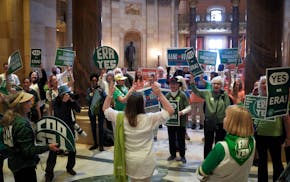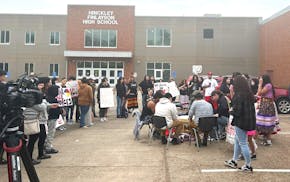David Pence's March 6 commentary "Our struggle: Redefining our friends and foes" was equally informative and important. And, while I agree with his observation that we need to resist the counterproductive temptation to attack our presidents with shallow sloganeering — as stated — it is important to learn from experience.
In particular, we should make note of the particularly wrongheaded approach taken by the neocons of the George W. Bush administration. After all, their arrogance and hubris was the prime mover in the chaos that now exists in the Middle East.
I mention this not to take a shot at the Bush II administration, but to point out that this foreign-policy model is alive and well among the current slate of Republican presidential candidates as well as possibly with Democratic front-runner Hillary Clinton.
The neocons of Bush II not only declined the sage advice of some of the principals of the Bush I administration in the lead-up to the Iraq invasion, but remain resolutely incapable of admitting their catastrophic folly. Heaven forbid, they could be recycled in a future Republican administration, and judging from election season rhetoric, it seems likely.
As Mr. Pence states: "We must hope the next president, whoever it is, will benefit from a clarified strategy worked out in congressional debates and informed by serious journalism and scholarship into the religious national and military realities that define our present predicament." I couldn't agree more. Hopefully our electorate does as well.
Gene Case, Andover
POLYMET MINE PROPOSAL
Big picture well presented in Sunday Star Tribune article
It is all too easy to oversimplify the PolyMet controversy as "jobs vs. the environment." The dynamics and effects of the worldwide copper market are important to understand. We also need to consider the financial incentives and business strategies that drive the decisions of PolyMet's investors. Josephine Marcotty makes these critical factors understandable ("PolyMet has green light, bad timing," March 6. Every citizen of Minnesota should read this excellent article. Whether for, against or undecided about copper-nickel mining, you will be more informed.
David Aquilina, Minneapolis
DONALD TRUMP
A perceived betrayal on the right is what fuels the phenomenon
While I enjoyed parts of D.J. Tice's March 6 commentary, especially the mention of how Hitler came to power as a populist ("Today's Trumpology: Is this one of history's rhymes?"), his implied claim that liberals are to blame for the rise of Donald Trump (the mention about how voters are suffering from secularism and multiculturalism, among other things) is too much to stomach. The voters in the Democratic coalition — Hispanics, blacks, the young, and the liberal — don't seem to be flocking to the Trump banner because they are dissatisfied with their party's candidates.
Rather, after 35 years of Republicans running this country, save for the first two years of both Bill Clinton and Barack Obama, the coalition between the traditional business base that has always wanted low taxes and less government spending, and the rural, Southern, less-educated voters who have been more concerned about social issues such as gun rights, homosexuality and abortion, is splitting wide open. The latter group has been told by the former just to go along with the so-called conservative movement's agenda and it would see improvements in economic status while the business base would work to implement the social causes agenda. That fraud has been exposed, and the blue collar half of the coalition is seeing the reality that their real income is now lower than before Ronald Reagan became president. While these voters could never support a liberal Democrat, they can also no longer support the business class of the Republican Party. This is what fuels the Trump phenomenon.
James Page, Coon Rapids
DOWNTOWN MINNEAPOLIS
Negative letter about Nicollet Mall really missed the mark
The North Loop is a dynamic neighborhood on the move. It's boosters need not denigrate other parts of downtown to extol its virtues. But a March 6 letter writer did just that by using inaccurate and selective information about Nicollet Mall.
Nicollet Mall has been an important part of Minneapolis infrastructure since the middle 1960s. The mall is undergoing reconstruction, starting with millions of dollars in private utility investment that will upgrade services for much of downtown. This will be followed by a $50 million public investment funded by the state, city and benefited property owners to transform the mall into a green, exciting, pedestrian-friendly main street for our city.
I'm uncertain which summer day the letter writer spent on Nicollet Mall when it appeared to him as a "cold, dark canyon." Certainly not a day when the farmers market — which will return upon project completion — transforms the mall into a magical, multiethnic melting pot.
Since my office is on Nicollet Mall, here is what I see every day: A home for many of the state's largest and most influential employers. Connection for the core of downtown to the region's burgeoning transit system. Retail that includes Macy's, Target, JB Hudson, Barnes and Noble, Hubert White (celebrating its 100th anniversary), Brooks Brothers, the soon to open Saks Off 5th and many others. Important civic/cultural/religious institutions like Orchestra Hall, Peavey Plaza, the Central Library, the YWCA and Westminster Church (which is also making an exciting investment in its continued future on the mall). And a strong restaurant scene that blossoms into vibrant sidewalk cafes during the spring, summer and early fall. Throw in the Dakota Jazz Club, major hotels, a new visitor center and high-rise downtown living, and the end result is an accurate depiction that stands in stark contrast to the negative view offered for reasons known only to the letter writer.
Steve Cramer, Minneapolis
The writer is president and CEO of the Minneapolis Downtown Council and Downtown Improvement District.
STATE BUDGET FORECAST
Sorry, baby boomer retirements don't explain lagging revenue
Our latest state budget forecast showed Minnesota employment, personal income and wage growth lagging the national average. This is a departure from history. It is also a major reason state government has less projected tax revenue available to it during the next two years.
I believe one reason for this is our state's climate of high taxes and heavy-handed regulation, which discourages business expansion and investment. I mentioned this the day the forecast came out.
But columnist Lori Sturdevant disagreed with my conclusions ("Jobs, jobs, jobs? We've got 'em, but we need more workers," March 6). Instead, Sturdevant concludes that our business climate has nothing to do with our lagging the national average in personal income, employment and wage growth. In her words, "[b]aby boom retirements are" the reason.
Really? Is Minnesota the only state that had a baby boom years ago? Is Minnesota the only state with a lot of retiring baby boomers?
Of course not. Every state is facing the retirement of its baby boomers. Yet Minnesota, which has traditionally exceeded the national average in employment, personal income and wage growth, is now lagging the national average in the growth of these measures.
Sturdevant goes on to talk about how the state needs to do more to help develop our state workforce, and I agree with some of her suggestions.
But lack of spending in these areas compared with other states is not why we are lagging national averages. Minnesota is a big spending state that already spends a lot in these areas. There are a host of studies indicating that Minnesota's subpar business climate is contributing to slower state growth. Hopefully this legislative session we can improve our state's business climate in a way that leads to personal income and wage growth above, and not below, the national average.
State Rep. Jim Knoblach, R-St. Cloud

Let voters decide on Equal Rights Amendment

Readers Write: Graduation, child care, midwifery, Timberwolves fans

How to avoid an Uber/Lyft disaster



